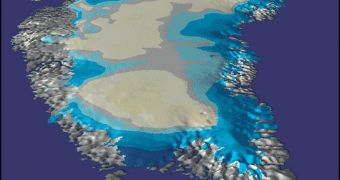NASA confirms it: the surface temperature of Greenland's ice sheet is going up, fueled by warming air, causing a melt at the surface of and throughout the mass of the ice cap. A total melting of the Greenland ice would raise sea level by about 23 ft (7.8 m). This may not happen, but Greenland has been adding 2 mm to the sea level annually, starting with the end of the 20th century. The new research published in the 'Journal of Glaciology' used the last NASA satellite technologies to investigate the phenomenon.
"The relationship between surface temperature and mass loss lends further credence to earlier work showing rapid response of the ice sheet to surface meltwater," said lead author Dorothy Hall, a senior researcher in Cryospheric Sciences at NASA's Goddard Space Flight Center, in Greenbelt, Md.
The team employed temperature data captured daily, from 2000 to 2006, with the Moderate Resolution Imaging Spectroradiometer (MODIS) instrument on NASA's Terra satellite, which detects modifications in the surface temperature to within about 1 degree C of accuracy from a distance of 440 mi (700 km) in space.
The monitoring was made within each of the 6 major drainage basins of Greenland's ice sheet to see how various portions react to higher air temperatures. The team also compared how variations in the surface temperatures were correlated with changes in the internal ice.
The team found a rapid ice loss on ice sheet surfaces in areas lower than 6,500 ft (2,170 m), all around the island. The team noticed that less than 2% of the ice sheet had to melt at the surface so that mass loss of ice would be induced. In 2004 and 2005, the GRACE satellites detected a rapid subsurface ice loss, less than 15 days after surface melting had occurred.
"We're seeing a close correspondence between the date that surface melting begins, and the date that mass loss of ice begins beneath the surface. This indicates that the meltwater from the surface must be traveling down to the base of the ice sheet -- through over a mile of ice -- very rapidly, where its presence allows the ice at the base to slide forward, speeding the flow of outlet glaciers that discharge icebergs and water into the surrounding ocean. If air temperatures continue rising over Greenland, surface melt will continue to play a large role in the overall loss of ice mass," said Hall.
The team also observed that various parts of the ice sheet were affected differently by air temperature increases, and this could be due to different climate factors. For example, the southern coastal sector of the ice sheet is at the point of reaching the melting point (0 degrees C) during the summer.

 14 DAY TRIAL //
14 DAY TRIAL //